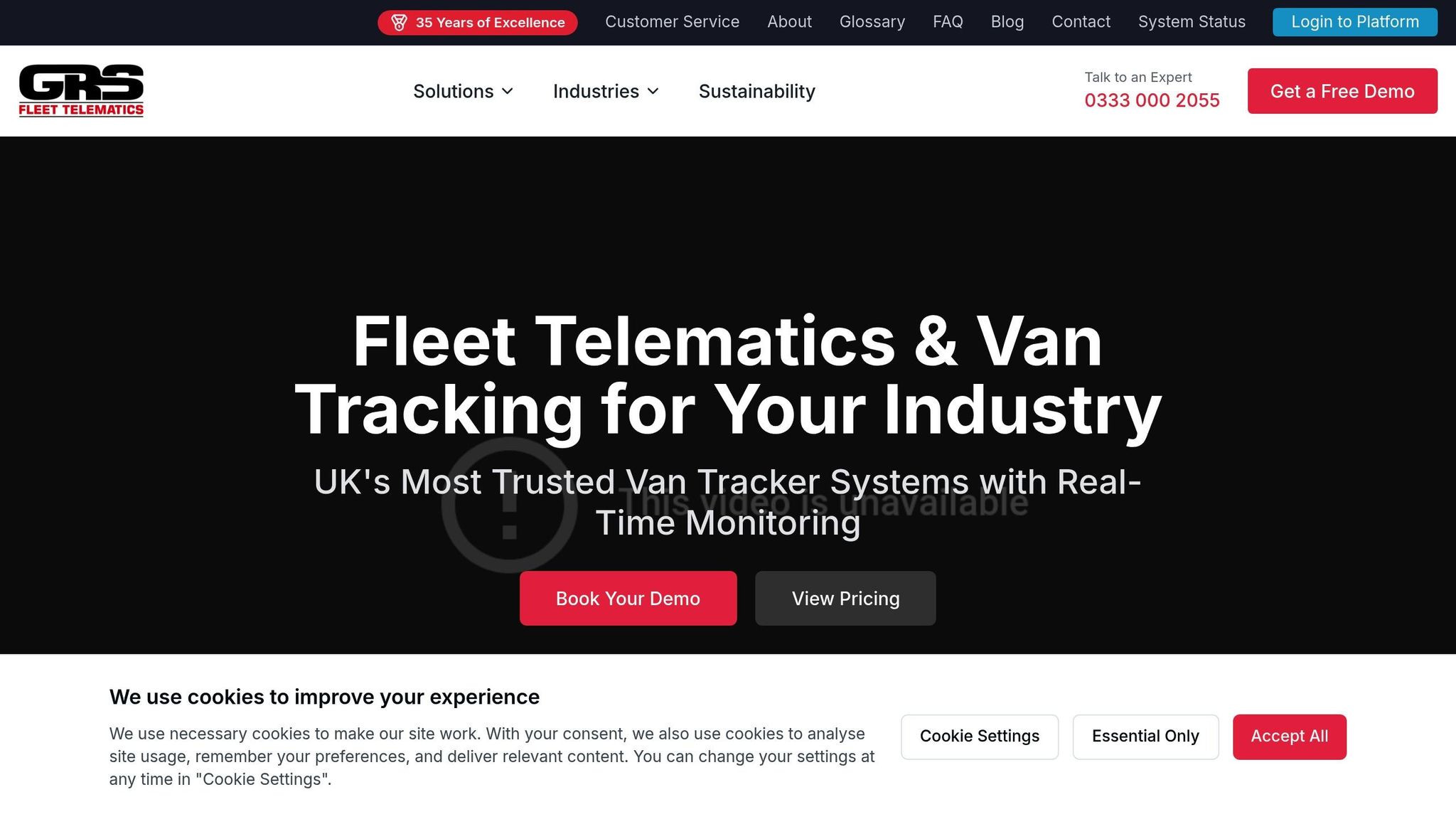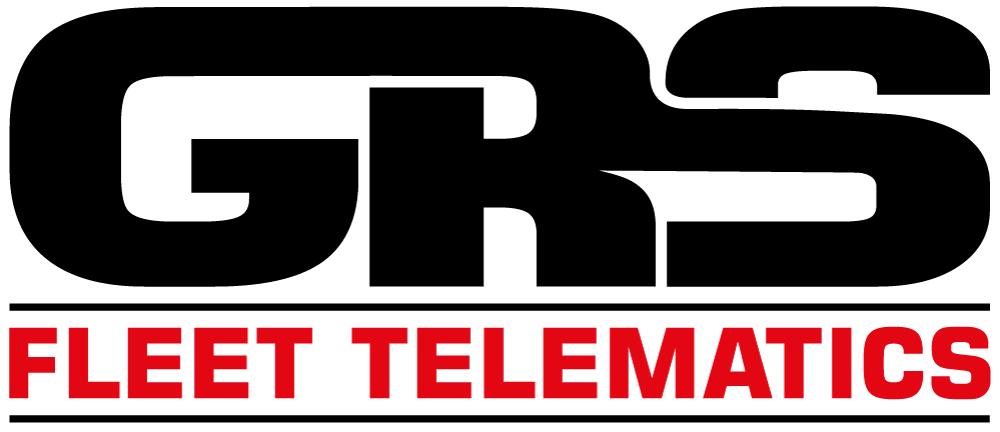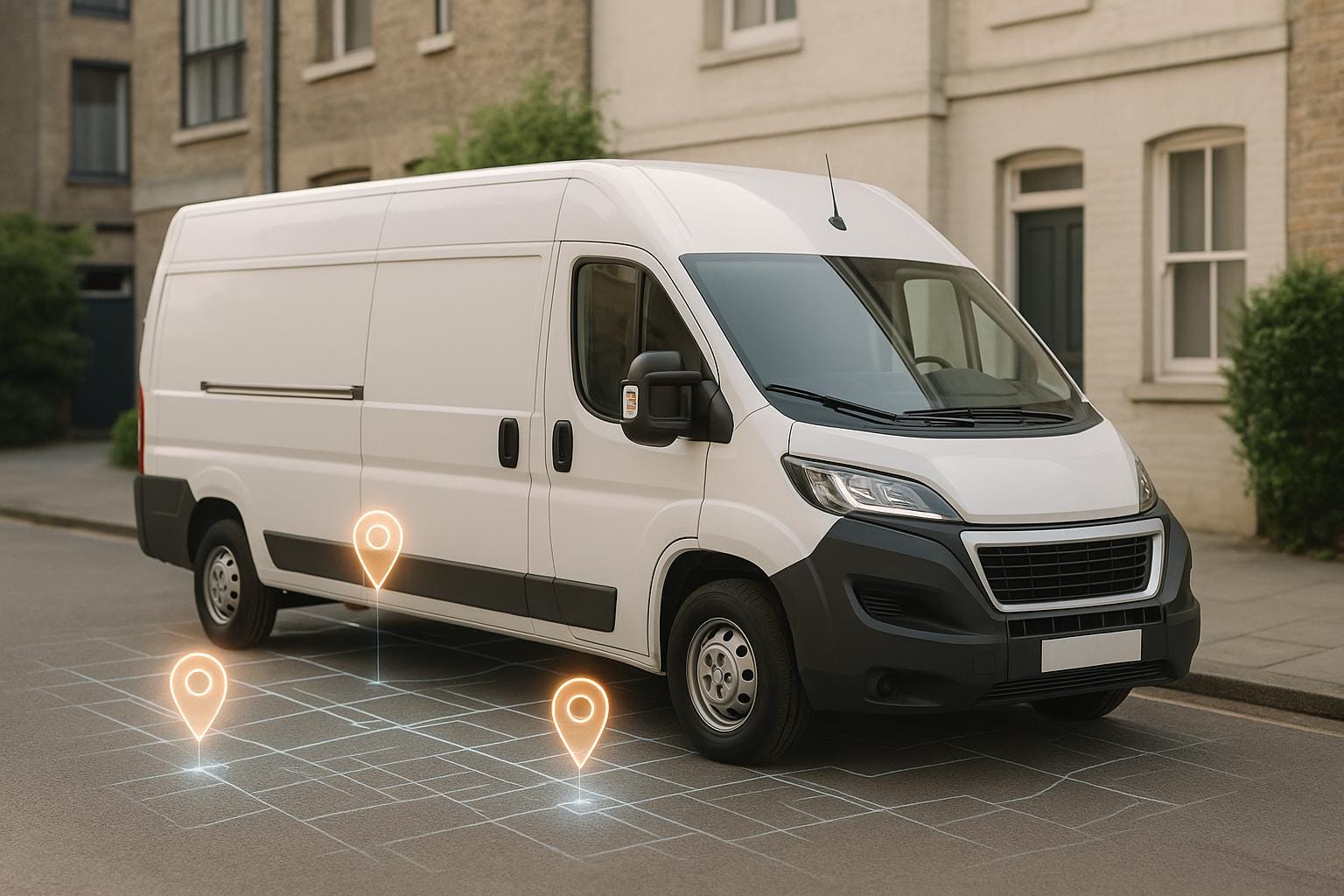Van tracking systems help UK businesses save money, improve vehicle security, and ensure legal compliance. Using GPS, telematics, and cloud software, they provide real-time data on vehicle location, fuel use, and driver behaviour. Here's what you need to know:
- Save Money: Cut fuel costs by up to 10%, reduce accidents by 21%, and lower maintenance expenses with proactive monitoring.
- Improve Security: Protect against theft with dual-tracker systems, achieving a 91% recovery rate for stolen vans.
- Boost Efficiency: Optimise routes, monitor driver performance, and ensure vehicles stay in top condition.
- Stay Compliant: Simplify GDPR, tachograph, and Direct Vision Standard (DVS) compliance.
Quick Comparison of GRS Fleet Telematics Packages

| Package | Features | Cost |
|---|---|---|
| Essential Package | Basic tracking with one wired tracker | £35 |
| Enhanced Package | Wired tracker + Bluetooth backup | £79 |
| Ultimate Package | Dual trackers + immobilisation | £99 |
Van tracking systems are an affordable and practical solution for businesses of all sizes, offering measurable benefits in cost savings, security, and operational efficiency.
GPS vehicle trackers - Pro Vs DIY - setup instructions
How Van Trackers Work
Van tracking systems use a mix of satellite technology, cellular networks, and vehicle diagnostics to provide real-time data about the vehicle.
GPS Location Tracking
Van trackers depend on a network of 24 satellites that send microwave signals containing position and timing details. By receiving signals from at least four satellites, the tracker calculates the vehicle's exact location through triangulation and precise timing.
Network Communication
Data from van trackers is sent through cellular networks to secure cloud servers. Here's how it works:
- GPS Module: Captures the vehicle's location.
- Cellular Modem: Sends the data over mobile networks.
- Cloud Server: Processes and stores the information.
- Fleet Platform: Displays the data in an easy-to-use interface for monitoring.
Vehicle Data Collection
The system connects to the vehicle's onboard diagnostics (OBD) port, gathering key performance details such as:
- Engine performance
- Fuel usage
- Speed and idle times
- Driving behaviour
- Diagnostic fault codes
"The in-vehicle telematics uses GPS technology to automatically provide location information along with other data such as date and time, vehicle diagnostics, engine management, and more".
These insights are the foundation for improving fleet management and efficiency.
Main Benefits for Fleets
Security Features
Modern van tracking systems are a game-changer in protecting vehicles, especially in high-risk situations. In 2024, the UK saw 11,273 vans stolen, with losses totalling around £200 million. GRS Fleet Telematics tackles this issue with dual-tracker technology - combining wired and Bluetooth trackers. This dual-layer approach makes disabling the system much harder for thieves and has achieved a 91% recovery rate for stolen vehicles, far surpassing the national recovery rate of 39%.
"While police efforts in recovering stolen vans is commendable, individual prevention remains the most effective way to deter thieves. This includes keeping keys in a Faraday pouch, parking in well‐lit areas, using a steering wheel lock, and installing a tracker or immobilizer."
– Eva Sandstra‐Bennett, Van Product Manager at Direct Line business insurance
But these systems aren’t just about security - they also bring operational advantages.
Fleet Performance
Van tracking systems can significantly improve how fleets operate by delivering real-time data. They help manage fuel use, optimise routes, and even predict when vehicles need maintenance. This level of control allows fleet managers to cut costs and increase efficiency.
| Performance Area | Benefits |
|---|---|
| Fuel Management | Real-time monitoring and dynamic route planning reduce fuel consumption |
| Route Optimisation | Traffic updates enable smarter, more efficient journey planning |
| Vehicle Maintenance | Predictive tools schedule servicing to prevent costly breakdowns |
These tools not only enhance performance but also help fleets stay on top of legal requirements.
UK Legal Requirements
Fleet operators in the UK face a range of regulatory obligations, and tracking systems can simplify compliance:
1. GDPR Compliance
Modern tracking systems include advanced privacy features, such as configurable settings for non-working hours, encrypted data storage, and controlled access. These safeguards help operators comply with GDPR and the Human Rights Act 1998, reducing the risk of hefty fines.
2. Direct Vision Standard (DVS)
For fleets operating in Greater London, tracking systems can integrate with safety features to meet DVS requirements. These updated standards take effect in October 2024.
3. Driver Hours Compliance
Automated systems for tracking driving hours ensure compliance with tachograph regulations, easing the administrative workload.
"It is illegal to track a vehicle without informing the driver. Transparency is essential to remain compliant and maintain employee trust."
– Fleetsmart
Setting Up Your Tracking System
Fleet Requirements
Start by evaluating your fleet's specific needs, considering factors like size, vehicle types, and operational goals. Here's a quick breakdown:
| Fleet Aspect | Key Considerations |
|---|---|
| Vehicle Types | Compatibility with mixed fleets and any specialised tracking needs |
| Coverage Area | Urban vs rural routes, plus any international travel requirements |
| Operating Hours | Whether the fleet runs 24/7 or sticks to standard business hours |
| Security Level | Basic tracking features or advanced options for higher security |
GRS Fleet Telematics offers three hardware options tailored to different needs:
- Essential Package (£35): Basic tracking with a single wired tracker.
- Enhanced Package (£79): Includes a primary tracker and a Bluetooth backup for added theft protection.
- Ultimate Package (£99): Features dual trackers and immobilisation for top-level security.
Once you've identified your fleet's needs, align team processes and system management accordingly.
Setup and Staff Training
A well-planned rollout and clear communication are key to getting staff on board and ensuring the system's success.
- Initial Communication: Hold in-person meetings to explain how the system works, including data collection, update schedules, and benefits for everyone involved.
-
Training Programme: Cover the following:
- How the system functions and daily operational steps
- Privacy measures and data protection policies
- Tips for using the system effectively
- Solutions for common technical issues
-
Policy Implementation: Establish clear rules for:
- Vehicle usage and restrictions
- Guidelines for personal journeys
- Speed monitoring practices
- Responding to system alerts and notifications
Once training and policies are in place, you can shift your focus to managing the system effectively.
System Management
To keep everything running smoothly, focus on these key management tasks:
| Management Aspect | Actions Required |
|---|---|
| Daily Monitoring | Check activity logs and address any alerts promptly |
| Regular Updates | Keep software and firmware up to date |
| Data Analysis | Review driver behaviour and fuel efficiency reports |
| Compliance Checks | Ensure GDPR compliance and update privacy settings as needed |
Use geofencing alerts to track unauthorised vehicle use and set up reminders for scheduled maintenance. The GRS Fleet Telematics platform also offers a mobile app for easy on-the-go monitoring and provides 24/7 technical support to assist with any issues.
Tracking System Costs vs Benefits
Money Saved Through Tracking
Van tracking systems can lead to significant savings. For example, a fleet of 20 vehicles could save over £4,800 per month through better management.
Here’s how tracking systems help cut costs:
Fuel Efficiency
- Tracking speeds above 60 mph is crucial, as every 5 mph increase can raise fuel consumption by about 10%.
- Reducing idle time to save fuel.
- Using route planning to limit unnecessary mileage.
- Adjusting routes in real time to avoid traffic jams.
Insurance Savings
Many UK insurers offer reduced premiums for fleets using tracking systems:
- Premium discounts of up to 30% with comprehensive tracking.
- Around 20% fewer accidents for vehicles equipped with tracking.
- Accident-related costs drop by 21%.
"21st Century Insurance gives 15 percent off its comprehensive coverage premium for theft recovery devices like GPS trackers. Nationwide offers anti-theft discounts based on the state you live in and based on the type of device you install. Geico says customers can get up to a 25 percent discount."
Tracking systems also cut maintenance costs by using proactive monitoring:
Maintenance Costs
- Monitoring speed helps lower maintenance expenses. For instance, increasing average speed from 60 mph to 70 mph can raise maintenance costs by over 75%.
- Automated service scheduling reduces the risk of expensive breakdowns.
These savings, combined with cost-effective setup, highlight the financial advantages of telematics systems.
Price Comparison
To understand the financial impact, compare upfront costs with long-term savings:
| Cost Category | Standard Management | GRS Fleet Telematics |
|---|---|---|
| Hardware Cost | £60–£300 per vehicle | From £35 (Essential Package) |
| Monthly Software | £15.95–£30 per vehicle | £7.99 per vehicle |
| Installation | £50–£125 per vehicle | Free with branding |
| ROI Timeline | 12+ months | As little as 6 months |
The GRS Fleet Telematics platform offers added perks, including:
- 24/7 recovery support.
- A 91% vehicle recovery rate.
- Dual-tracker technology for better security.
- Free installation when paired with fleet branding.
Fleets using telematics often see:
- Up to 10% reduction in fuel consumption.
- A 21% decrease in accident costs.
- Improved driver safety.
- Automated maintenance scheduling.
For many UK fleets, these systems can pay for themselves in just six months through savings on fuel, insurance, and maintenance. Choosing the right package based on fleet size and needs is key to maximising these benefits.
Conclusion
Van tracking systems have become a key tool for modern fleet management, offering measurable benefits in security, efficiency, and compliance. These systems not only improve daily operations but also deliver cost savings and peace of mind for businesses.
Fleet managers have highlighted notable savings. For example, one manager shared that monitoring driver behaviour "saved us £160,000" and improved fuel efficiency by 12% (MPG).
Better Security and Theft Recovery
Using dual-tracker technology - combining a wired GPS tracker with a hidden Bluetooth backup - provides strong protection against theft. This added layer of security helps businesses feel more assured and can even lead to reduced insurance costs.
Improved Operational Efficiency
Real-time tracking tools and route planning have revolutionised fleet operations. These features allow managers to respond quickly to traffic issues and optimise routes for better time and fuel management. For instance, M&Y Maintenance & Construction enhanced their fleet's performance with driver monitoring systems.
Affordable and Practical Solutions
Modern tracking systems are designed to be budget-friendly, with low setup costs and minimal ongoing expenses. This affordability, combined with the operational savings they provide, makes them a smart investment for fleets of all sizes.
"The system provides a fast and reliable audit of who attended each job and when"
– Supervisors at M&Y Maintenance
Incorporating van tracking systems into fleet management can bring immediate and lasting benefits. By improving security, boosting efficiency, and ensuring compliance, these tools are reshaping fleet operations across the UK.
FAQs
How can van tracking systems help businesses comply with UK regulations?
Van tracking systems play a crucial role in helping businesses meet UK legal requirements for fleet operations. These systems provide detailed data to monitor drivers' working hours, ensuring compliance with rules like the Working Time Directive and tachograph regulations. They also help track vehicle maintenance schedules, reducing the risk of fines or penalties for operating unroadworthy vehicles.
Additionally, tracking systems can monitor speed and driving behaviour, ensuring adherence to speed limits and promoting safer driving practices. By automating these processes, businesses can stay compliant while improving efficiency and protecting their assets.
How can van tracking systems save your business money and improve operations?
Van tracking systems can deliver significant cost savings and operational benefits for businesses. By monitoring routes and driving behaviour, they help reduce fuel consumption, cut down on unnecessary mileage, and minimise vehicle idling, which can lead to fuel savings of up to 25%. Additionally, they help lower overtime claims and improve scheduling, enhancing overall efficiency.
These systems also contribute to better vehicle maintenance by tracking usage and identifying potential issues early, reducing repair costs. With improved route planning and real-time updates, businesses can provide faster, more reliable customer service, leading to higher satisfaction rates. Together, these benefits often result in a positive return on investment (ROI) within a year, making van tracking systems a smart choice for optimising fleet operations and protecting assets.
How does dual-tracker technology improve fleet security?
Dual-tracker technology enhances fleet security by using two independent tracking systems, providing an extra layer of protection against theft or tampering. Typically, one tracker operates openly, while the second is concealed, making it harder for thieves to disable both systems.
This setup ensures that even if one tracker is compromised, the other continues to provide location data, increasing the chances of recovering stolen vehicles. For businesses, this added security helps safeguard valuable assets and reduces the risk of financial losses.

